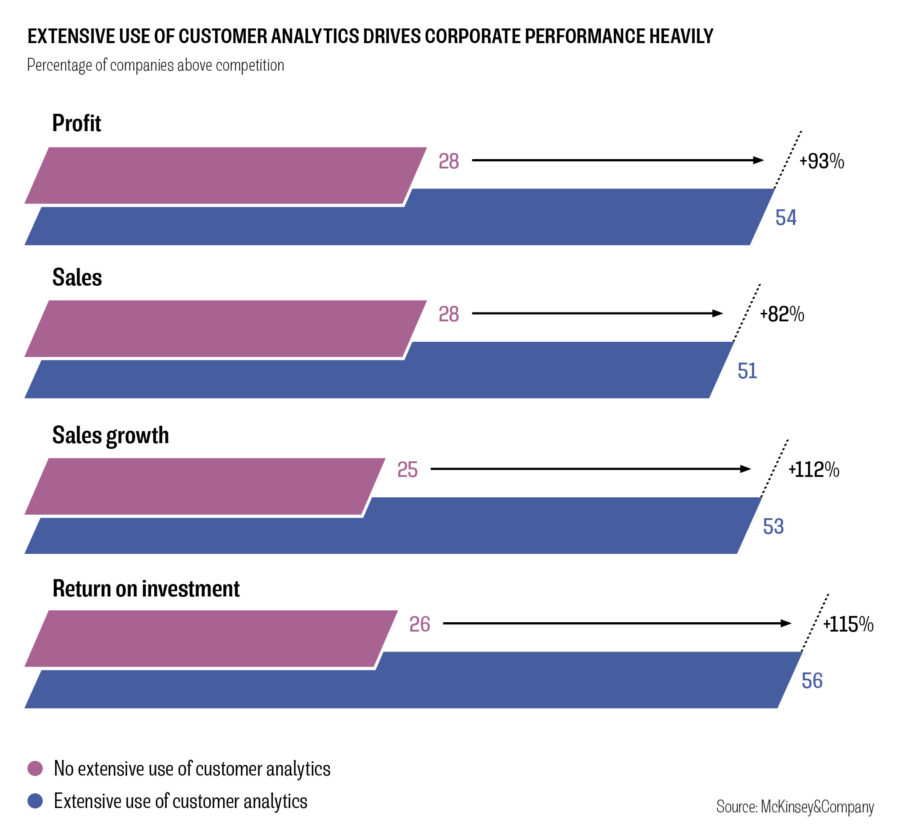Today’s data-driven world sees us generate 2.5 quintillion bytes every day, with IBM estimating that 90 per cent of the world’s data was created in the past two years.
What does the daily onslaught of social media content, increasingly intuitive and connected devices, artificial intelligence and cloud-based software mean for businesses, and how does it translate to a company’s bottom line?
International Data Corporation predicts that by 2020 organisations able to analyse effectively all their relevant data and deliver “actionable” information from it will achieve an extra $430 billion in productivity benefits. So the financial potential is clearly huge.
For Andrea Peyracchia, digital partner at McKinsey, the greatest opportunity lies in the business-to-business space. Here, he says, it is no longer about the raw data, but about harnessing and internalising its use to ensure improved efficiencies across production and manufacturing, logistics and distribution, and ultimately the end-customer experience, be that industry, wholesale, retail or end-user.
“By working with partners and integrating the supply chain you can use data to cut lead times and stock levels aggressively or even launch new business models. You can use predictive maintenance data to reduce machinery downtime or hedge the cost of fuel, buying when oil is low and vice versa to maximise margins,” he says.
In the consumer sphere, the opportunity is equally vast. Our desire for continuous connectivity has brought major changes to the way we work and play. When shopping, consumers are using both digital and physical channels when they buy. Google estimates that more than 85 per cent of UK and US shoppers research online before making an offline purchase. This means it is ever-more important for consumer-facing companies to understand how various devices, channels and media influence buying decisions.

Location location location
Mobile devices continue to grow in importance for retail. While people do purchase from mobile devices, they are currently used more for price comparison, reading reviews, sharing or cross-referencing on social media. According to Google, searches on mobiles that included “near me” increased threefold in 2015 and this trend is showing no signs of slowing.
Tom Salmon, partner in 3i’s private equity team, sees mobile usage permeating the whole retail experience, such as through “stickers” on garment tags to help retailers understand their customers’ path around the store and engagement with their merchandise. Rather than just relying on sales data, this can help inventory management, and enable more effective merchandising and store planning.
“At the moment, customer journeys around a store are largely based on anecdotal evidence from retail staff. What we are starting to see is that process becoming much more data-driven, enabling retailers to become more sophisticated in how they merchandise stores,” says Mr Salmon.
This can lead to significant changes. For example, Honest Café, a UK coffee shop chain, is using cognitive analytics from IBM to explore vending machine transactions, payments and weather data, find correlations and suggest previously unseen patterns in customer behaviour. As a result, Honest Café is now transforming its store layouts to encourage longer visits and upselling.
Omnichannel
The digital journey for many retailers is increasingly about offering an omnichannel experience. In making the customer central to the strategy, the channel itself becomes less relevant, while the customer’s convenience and enriched personalised experience take priority. John Lewis believes omnichannel customers are three to four times as valuable as a single-channel customer.
Capturing the data is one thing, but how it is used and by whom often presents the bigger challenge
Both showrooming, where customers browse in-store and then buy online, and webrooming, where customers research online and then buy in-store, are increasingly popular. According to Forrester, webrooming will result in $1.8 trillion in sales by 2017 compared with an estimated total e-commerce sales figure of $370 billion.
Harnessing data
Capturing the data is one thing, but how it is used and by whom often presents the bigger challenge. 3i’s Mr Salmon believes it is crucial that data sits in the hands of the people owning the business decisions, rather than the hands of the most technically competent.
“The IT team might craft the best software solution, but they won’t necessarily think about the business decision they’re trying to solve. So there’s a big piece around leadership,” he says.
Mr Salmon gives an example of how 3i is exploring this with its portfolio companies. “We recently held a customer analytics workshop here in London,” he says. “We brought together chief marketing officers from across our consumer portfolio companies, as well as network contacts from leading technology companies, including Google, Facebook and Instagram, to debate how companies can ensure they are addressing the customer analytics agenda effectively.”
Key takeaways? Start small, focus on your minimum viable product (MVP) and getting new ideas out, then learn and move on. An MVP is a product with just enough features to gather validated learning; it won’t be perfect, but can be less expensive and less risky than developing a product with more features, and a good way to become a little less wrong every day.
As Vince Darley, chief scientist at King.com, points out, data is meaningless on its own. “It must be coupled with a customer-centric focus and used to understand customer behaviours and needs. There is a wealth of data out there, so focusing on the relevant data, together with the underlying story, is paramount if you are going to improve the customer journey in a meaningful way,” he says.
“You need to experiment, you need to understand the results and then move quickly to respond. It is this innovation, failing fast, constant evolution and fast turnaround that are key in discovering great things.”

